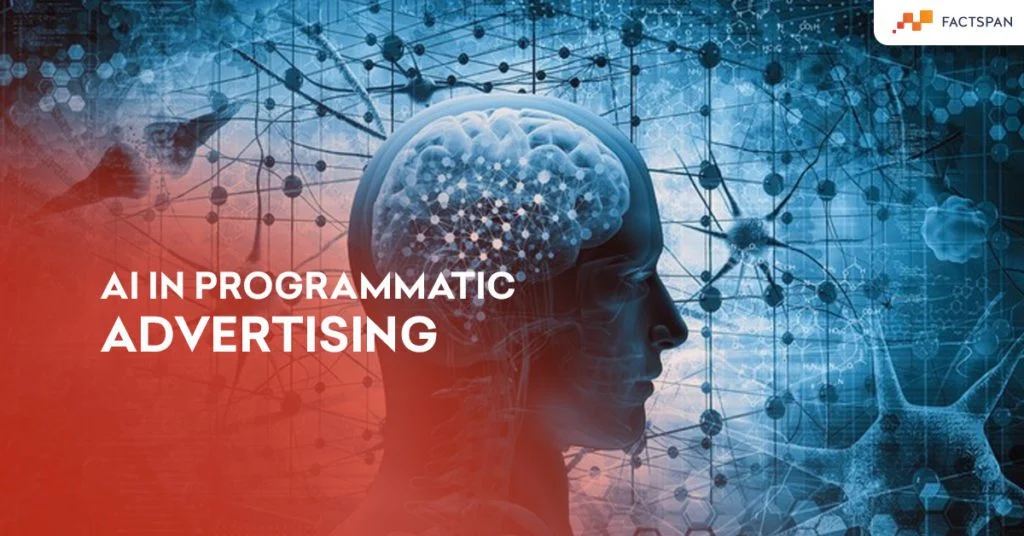When AI is present, 49% of consumers are willing to shop more frequently while 34% will spend more money – Source: PointSource
Programmatic Advertisement is a common ground consisting of Advertisers and Publishers where an auction-based system offers them automated buying and selling of the Advertising space on the web. This innovative tool has been quite a buzzword for the past decade now and so many companies are still trying to harbor its potential. Programmatic advertising is the base when it comes to optimizing the online marketing Ad campaigns in the B2B and B2C ecosystems. It refers to automated trading with ad space to target the right audience at the right moment in time.
If we turn our heads towards the biggest real-world example, the duopolists Facebook and Google are at the forefront. Both have the database and right tools to display ads to the targeted audience set, thus being the beneficiaries of programmatic advertising. But, one must be wondering how AI can participate in an already automated environment of this advertising ecosystem? What role is it when we talk about AI in programmatic advertising?
Let’s try to figure it out next.
Role of AI in Programmatic Advertising?
User behavior may be typically difficult to understand without solid data and an excellent algorithm. This is where AI comes in handy to improve user experience and optimizing the programmatic space. With AI in programmatic advertising, it consistently becomes easier to analyze user behavior, optimize Ad sets for different groups of users thus targeting them with Ads that can be improved in real-time.
AI- algorithms can learn from and adapt their actions based on new user patterns and data they come across which becomes an essential part when it comes to real-time optimization under programmatic advertising campaigns. Being highly capable of processing scores of data sets, AI is extensively suitable here and helps in influencing different aspects of programmatic advertising like:
- Content Matching: A basic and most crucial aspect of advertising is content matching which refers to matching the content of an Ad set with that of websites where the Ads are to be displayed. The NLP or natural language processing component of AI helps in achieving the same so that the Ad is placed only at those websites where it is highly relevant and has an optimum probability of being discovered. This makes sure that any Advert is not displayed anywhere with an improper context.
- Customization: When it comes to user-based content, AI works wonders in the field of personalization or customization. It collects humongous datasets from websites where people visit, process, and segment audiences thus serving relevant and more personalized content to them.
- Graphic Personalization: AI can very well predict which form of the graphic will work best for a particular set of audiences. In fact, post the launch of an Ad set, AI can be used to adjust the Ad graphics viz. Video, carousel, slideshow, poster, infographic, etc. based on the user experience and their inclination towards a certain type of visual they see and make a buying decision. For instance, using an AI video maker can streamline the creation of tailored video content, enhancing audience engagement and conversion rates.
- Budget Optimization: AI may act as an economical fairy when it comes to adjusting bidding strategies for advertisers based on their client information. Suggesting optimum bidding price for the Ad space they are looking to buy, AI helps reducing AD spend and improving ROI on a particular campaign.
In fact, even bidders can benefit from this. AI helps advertisers to predict how successful their Ad campaign would become thus benefiting publishers to limit their auction only to certain advertisers.
Do you know Netflix saves $1 Billion a Year with AI? Click to read!
Sentiment Analysis using AI – A Ray of Sunshine for Programmatic
Now one would ask, what sentiment analysis is and why is it really required to be analyzed for an AD campaign to be launched? Well, imagine you’re happy today and looking out for some good furniture where Google is collecting your data based on what kind of product interests you the most so that it can use the information to retarget you again for the same product expecting you to take a buying action. But after you had a bad day, you’re somehow in a cranky mood when you open your browser now. What do you think would happen if you see a furniture Ad at this moment? Well, maybe now your mood directly affects your buying decision.
So, here’s where sentiment analysis comes in. In terms of programmatic advertising, it means identifying the mood of a viewer or customer who is about to see an Ad and predict if they are more likely to buy after looking at it. How does AI help in sentiment analysis:
- Through NLP, it analyzes the sentiment of the content that is viewed by the customer and predicting what type of Ad will perform better alongside that content.
- Through Facial recognition, AI identifies the user’s mood and modifies the Ad set in real-time based on the viewer’s emotional know-how.
- By analyzing customer’s browsing history and the situations where they have taken a buying decision after looking at a certain piece of content.
Conclusively, it is evident from the above-stated information that both ends of the programmatic parties including Advertisers and Publishers benefit from the real-time applications of AI in advertising. But, it is undeniable that customers too will get benefit in the future once this innovation comes live. All of us can expect more relevant, clickable content leaving out unnecessary and disruptive parts. We think that implementing AI in the field of programmatic advertising would make both the advertisers and publishers, use customer data more responsibly. Hence, our future decision-makers should leverage the potential of AI in advertising to be better beneficiaries.










